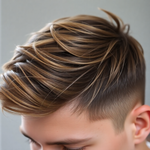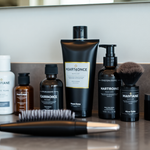
Micro-Changes, Major Impact: Semi-Permanent Hair Color to Make Your Sustainable Men's Capsule Wardrobe More Versatile
05 September 2025
Share
Introduction — Why one small change can feel like a wardrobe upgrade
Micro-Changes, Major Impact: Semi-Permanent Hair Color to Make Your Sustainable Men's Capsule Wardrobe More Versatile is about a simple, low-risk way to refresh your look without buying a single new item. If your capsule wardrobe feels repetitive or you're preparing for a season of important events, a subtle hair tone shift can alter how your staples read — making the same jacket, knit, or sneaker feel like a brand-new outfit.
Micro-Changes, Major Impact: Semi-Permanent Hair Color to Make Your Sustainable Men's Capsule Wardrobe More Versatile
This section keeps the focus tight: semi-permanent hair color is the quickest aesthetic lever you can pull to add variety, reduce shopping impulse, and stay loyal to sustainable style principles.
Why semi-permanent hair color fits sustainable men's style
Sustainability in fashion isn't just about fabric content and production ethics — it's also how you extend the life and perceived variety of what you already own. Semi-permanent hair color aligns with that principle because it:
- Reduces the need for additional garments to change your look.
- Lessens salon frequency compared with permanent color, lowering travel and product waste.
- Usually contains gentler chemistries and fewer long-term commitments, especially in modern, plant-forward formulas.
Core benefits at a glance
- Immediate impact: Change your visual profile in under an hour.
- Low commitment: Fades over 4–8 weeks so you can experiment.
- Hair health: No developer/ammonia in many semi-permanent formulas.
- Outfit versatility: Warm or cool shifts can make your capsule colors pop differently.
- Eco wins: Fewer salon visits and less product turnover.
How to choose the right shade for your wardrobe
Think of hair color as an accessory that should work with the majority of your closet. Use this decision tree:
- Audit your wardrobe palette: Are you mostly cool (navy, grey, black), warm (olive, tan, rust), or mixed?
- Decide contrast level: Higher contrast (darker hair with lighter clothes) reads sharper; lower contrast (similar tones) reads more cohesive and relaxed.
- Pick a shade family: Ash/cool shades for cool wardrobes; chestnut/caramel for warm wardrobes; neutral browns for versatility.
Choosing by skin tone and hair type
Match color to complexion and texture to avoid clashes:
- Fair skin: Cool ash or neutral browns preserve natural balance; avoid overly orange warms unless that's the intended bold move.
- Medium/olive skin: Warm chestnuts, subtle auburn, or soft golds enhance warmth and pair well with earthy capsule colors.
- Dark skin: Rich espresso, warm chocolate, or subtle caramel highlights add dimension; avoid shades that wash out your natural depth.
- Curly or coarse hair: Semi-permanent color is gentler but can highlight texture. Use moisturizing formulas and add a leave-in conditioner.
- Fine or thinning hair: Choose shades that add perceived density — slightly darker roots with softer ends create depth.
Salon vs. DIY: what to consider
Both paths have pros and cons. Here's the quick comparison so you can decide based on budget, skill, and sustainability priorities.
- Salon: Pros — professional color matching, even application, expert advice. Cons — higher cost, travel emissions, and sometimes frequent touch-ups.
- DIY: Pros — lower cost, control over timing, less travel. Cons — learning curve, potential for uneven results if rushed.
For sustainable outcomes: choose a salon that uses low-impact products or a DIY brand with concentrated formulas and recyclable packaging.
Step-by-step: safe at-home application
Follow this routine to get a clean, sustainable DIY result.
- Patch test 48 hours prior to full application.
- Gather reusable tools: mixing bowl, brush, old towel, and gloves you can reuse or recycle.
- Work on dry, unwashed hair so scalp oils protect your skin and the color grabs evenly.
- Section hair into quadrants for consistent coverage. Apply from back to front and ends to roots (if the formula instructs this order).
- Time strictly as product specifies. Semi-permanent dyes often develop faster than permanent ones.
- Rinse in cool water, then use a color-depositing conditioner to lock tone and add moisture.
- Dispose of minimal packaging responsibly — recycle where possible.
Maintenance timeline: what to expect week-by-week
Plan care so color looks intentional, not faded randomly.
- Week 1: Color looks freshest. Avoid chlorine and long sun exposure.
- Weeks 2–4: Slight fade begins. Introduce a color-depositing conditioner once weekly to revive tone.
- Weeks 4–8: Depending on formula and hair porosity, color will mellow. Reapply if you want to maintain intensity, or let it fade for a natural look.
Styling strategies to multiply capsule outfits
Here are actionable pairings to squeeze maximum versatility from both hair and wardrobe staples.
- Neutral deepening: Slightly darker hair with a navy blazer and white tee creates a polished, modern silhouette — great for interviews and dates.
- Warm dimension: Soft bronze highlights with cream knits and olive chinos for weekend warmth and texture.
- Cool ash: Ashier tones with charcoal and slate blues keep minimalist looks crisp and intentional.
- Accent contrast: If you add a subtle highlight or lighter edge, pair it with scarves or beanies that pick up the new tone for cohesion.
Practical outfit combos — real examples
- Young professional: Espresso hair, grey suit, navy knit tie, black oxford shoes — sharper contrast for office confidence.
- Creative type: Warm chestnut hair, vintage denim jacket, off-white tee, leather Chelsea boots — textural, lived-in aesthetic.
- Weekend minimalist: Neutral brown hair, olive chore jacket, slim black jeans, Menll.com EcoSneak for low-key urban style.
Color chemistry basics (so you can read labels)
Semi-permanent dyes deposit pigment without lifting your natural color because they don’t use high-volume developers. Look for labels mentioning:
- Direct dyes or deposit-only formulas
- Conditionality about ammonia-free or peroxide-free
- Plant-derived pigments or reduced PPD content
These terms usually indicate gentler options, but still do a patch test and read ingredient lists if you have sensitivities.
Troubleshooting — common problems and fixes
- Too warm/orange: Use a color-depositing shampoo/conditioner with ash or cool tones to neutralize brassy warmth.
- Uneven color: Apply a refresh to lighter sections only, or visit a pro for a toner correction.
- Fast fading: Switch to sulfate-free shampoos, wash less, and use cold rinses to preserve pigment.
FAQs — quick answers
- Will semi-permanent color cover grey? It can blend greys and reduce their visibility, but thick, dense greys may need repeated applications or a demi-permanent formula for fuller coverage.
- How often do I need to refresh? Typically every 4–8 weeks depending on desired intensity.
- Is it safe for colored or chemically-treated hair? Generally yes — semi-permanent is less aggressive, but consult product guidance and do strand tests.
Cost and sustainability comparison: salon vs. DIY
Budget and environmental impact both favor strategic DIY for small tone shifts. Here's a quick comparison:
- Salon session: $60–$150 depending on city and service. Higher immediate carbon footprint (travel) but professional finish.
- DIY kit: $15–$40 per application. Lower cost and fewer trips, but requires time and proper disposal of packaging for sustainability.
Case study — Jake, 29: one change, many compliments
Picture this: Jake works in product design, owns a compact capsule wardrobe of neutrals, and felt stuck in the same casual/formal divide. He chose a neutral brown semi-permanent tint that deepened his natural color. Result: his navy blazer looked sharper, knitwear felt warmer, and he received repeated compliments at work — all without buying new clothes. He refreshed every 6 weeks and noticed fewer impulse purchases because he felt refreshed.
Where to shop and what to try
For capsule-ready pieces that pair well with a refreshed look, Menll.com’s outerwear and footwear collections are minimalist and sustainable. Check Menll.com outerwear for layering options that play well with new hair tones: Menll.com outerwear. For grooming essentials, explore Menll.com’s grooming page for sulfate-free shampoos and conditioners designed to protect color: Menll.com grooming.
Image ideas, captions, and alt text for the post
Include visuals that reinforce the message. Suggested images:
- Hero image: a man in a neutral blazer with fresh, natural-looking hair. Caption: "Micro-change, major upgrade — fresh hair, same capsule." Alt: "Man wearing navy blazer and neutral hair tone in urban setting."
- Before/after split: subtle change in hair tone paired with same outfit. Caption: "One tone tweak, two vibes." Alt: "Before and after semi-permanent hair color on man with grey background."
- Step-by-step kit layout: reusable tools and product tubes. Caption: "Sustainable tools for at-home color." Alt: "Reused mixing bowl, brush, and eco-friendly hair color tubes on wooden surface."
Meta — SEO-ready title and description
Meta Title (55 chars): Micro-Changes: Semi-Permanent Hair Color for Capsule Style
Meta Description (156 chars): Micro-changes using semi-permanent hair color can expand your sustainable men's capsule wardrobe — tips on shades, maintenance, and styling.
SEO checklist — how this post is optimized
- Primary keyword used in the page title, first 100 words, one subheading, and repeatedly across the body.
- Related secondary keywords included: "men's capsule wardrobe," "sustainable men's style," and "semi-permanent hair dye."
- One external high-authority link for safety guidance: WebMD overview on hair dye (WebMD).
- Two internal links to Menll.com product/collection pages for cohesion and conversion.
- Clear headings (H2) for structure and scannability.
Final checklist before you make the change
- Decide how dramatic you want the change — subtle vs. noticeable.
- Choose a shade that complements your capsule palette and skin tone.
- Pick a gentle formula and do a 48-hour patch test.
- Plan maintenance: sulfate-free shampoo, color-depositing conditioner, and less frequent washing.
- Reduce waste: reuse tools and recycle packaging where possible.
Wrap-up — one small step for style, a big step for versatility
Micro-Changes, Major Impact: Semi-Permanent Hair Color to Make Your Sustainable Men's Capsule Wardrobe More Versatile proves that you don't need another wardrobe overhaul to feel different. A considered hair tone change multiplies outfit possibilities, boosts confidence, and supports a sustainable approach to personal style. Which micro-change will you try first? Share your plan in the comments or explore Menll.com for capsule-ready layers that pair perfectly with your new look.
Vorheriger Beitrag

Low-Waste Color Lab: Experiment with Semi‑Permanent Hair Color to Optimize Your Sustainable Men's Capsule Wardrobe
Aktualisiert am 06 September 2025
Nächster Beitrag

Semi-Permanent Hair Color as a Closet Strategy: Build a Sustainable Men's Capsule Wardrobe
Aktualisiert am 04 September 2025





